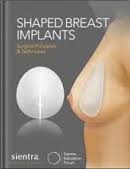
The shaped silicone breast implant offers several advantages for certain women, most notably creating a greater likelihood that the breast will look more natural and not so round. This can be particularly useful in breasts that have a small amount of ptosis (sagging) where the additional volume can help fill out the bottom half of the breasts better. Because of its shape it will not look so high initially and settles into a more natural breast shape sooner after surgery.
Because a shaped silicone breast implant has a specific form that will only look right in one position, its outer shell has a textured or irregular surface. The purpose of this shell lining is to allow the body (scar tissue) to grab onto it and hold it into its exact position so that it does not rotate after surgery. This is unlike a smooth round silicone breast implant which can rotate around without causing any external breast deformation.
The textured surface of a silicone shaped breast implant has one disadvantage, it is stiffer and has a more firm structure. This can make it harder to insert through small inframammary skin incisions. Usually larger skin incisions are needed to permit it to be inserted and oriented properly. This feature can be circumvented by using a funnel insertion technique.
Using a breast funnel, the textured shaped implant is placed into it after activating its internal lining by saline fluid. The shaped breast implant needs to placed into the funnel with the smaller upper pole towards the smaller tapered end. The vertical orientation line on the implant (Sientra shaped breast implants) should be placed upward so it is easily seen.
With a prepared funnel insertion device, it is inserted into the small inframammary incision and squeezed into the breast pocket. Due to the placement of the shaped implant in the funnel, it will end up in the proper vertical orientation without having to even touch the implant.
The need for larger skin incisions and manipulation of the shaped silicone breast implant inside the submuscular pocket for proper orientation can be completely overcome by a funnel insertion technique.
Dr. Barry Eppley
Indianapolis, Indiana


